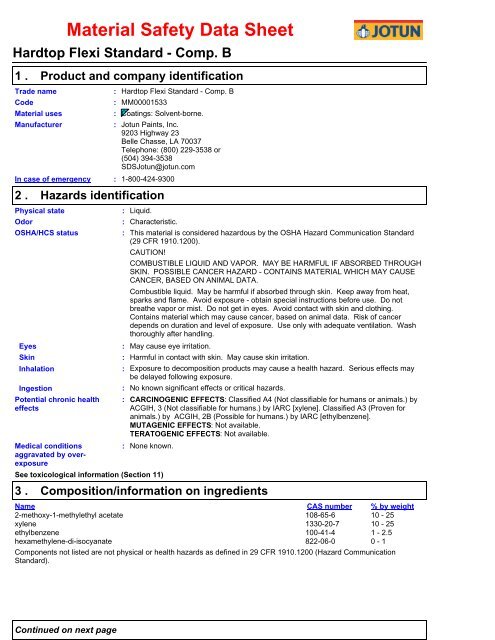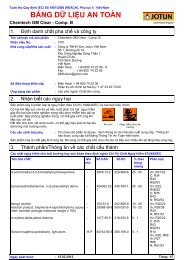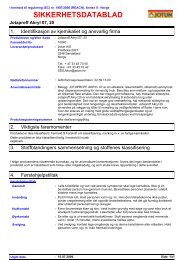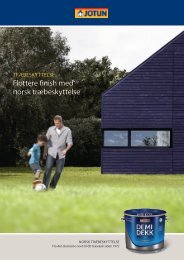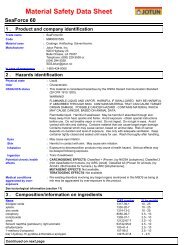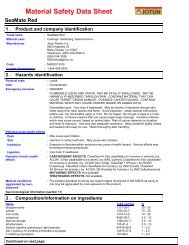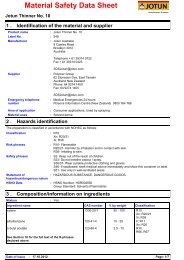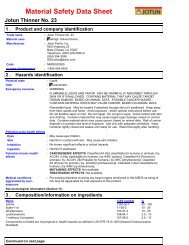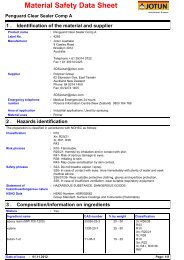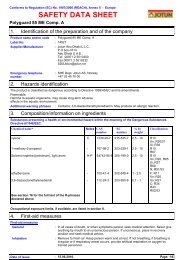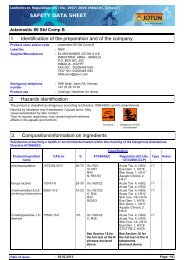Hardtop Flexi Standard - Comp. B - Marine_Protective - English - Jotun
Hardtop Flexi Standard - Comp. B - Marine_Protective - English - Jotun
Hardtop Flexi Standard - Comp. B - Marine_Protective - English - Jotun
- No tags were found...
Create successful ePaper yourself
Turn your PDF publications into a flip-book with our unique Google optimized e-Paper software.
Trade nameCodeMaterial usesManufacturerIn case of emergencyMaterial Safety Data Sheet<strong>Hardtop</strong> <strong>Flexi</strong> <strong>Standard</strong> - <strong>Comp</strong>. B1 .2 .Physical stateEyesSkinInhalationIngestionProduct and company identification: <strong>Hardtop</strong> <strong>Flexi</strong> <strong>Standard</strong> - <strong>Comp</strong>. B: MM00001533: Coatings: Solvent-borne.: <strong>Jotun</strong> Paints, Inc.9203 Highway 23Belle Chasse, LA 70037Telephone: (800) 229-3538 or(504) 394-3538SDS<strong>Jotun</strong>@jotun.com:1-800-424-9300Hazards identificationOdorOSHA/HCS statusPotential chronic healtheffectsMedical conditionsaggravated by overexposureSee toxicological information (Section 11)3 .: Liquid.: Characteristic.: This material is considered hazardous by the OSHA Hazard Communication <strong>Standard</strong>(29 CFR 1910.1200).CAUTION!COMBUSTIBLE LIQUID AND VAPOR. MAY BE HARMFUL IF ABSORBED THROUGHSKIN. POSSIBLE CANCER HAZARD - CONTAINS MATERIAL WHICH MAY CAUSECANCER, BASED ON ANIMAL DATA.Combustible liquid. May be harmful if absorbed through skin. Keep away from heat,sparks and flame. Avoid exposure - obtain special instructions before use. Do notbreathe vapor or mist. Do not get in eyes. Avoid contact with skin and clothing.Contains material which may cause cancer, based on animal data. Risk of cancerdepends on duration and level of exposure. Use only with adequate ventilation. Washthoroughly after handling.: May cause eye irritation.: Harmful in contact with skin. May cause skin irritation.: Exposure to decomposition products may cause a health hazard. Serious effects maybe delayed following exposure.: No known significant effects or critical hazards.: CARCINOGENIC EFFECTS: Classified A4 (Not classifiable for humans or animals.) byACGIH, 3 (Not classifiable for humans.) by IARC [xylene]. Classified A3 (Proven foranimals.) by ACGIH, 2B (Possible for humans.) by IARC [ethylbenzene].MUTAGENIC EFFECTS: Not available.TERATOGENIC EFFECTS: Not available.:None known.<strong>Comp</strong>osition/information on ingredientsName CAS number % by weight2-methoxy-1-methylethyl acetate 108-65-6 10 - 25xylene 1330-20-7 10 - 25ethylbenzene 100-41-4 1 - 2.5hexamethylene-di-isocyanate 822-06-0 0 - 1<strong>Comp</strong>onents not listed are not physical or health hazards as defined in 29 CFR 1910.1200 (Hazard Communication<strong>Standard</strong>).Continued on next page
<strong>Hardtop</strong> <strong>Flexi</strong> <strong>Standard</strong> - <strong>Comp</strong>. B Page: 2/84 .First aid measuresEye contactSkin contactInhalationIngestionProtection of first-aiders::::Check for and remove any contact lenses. Immediately flush eyes with plenty ofwater for at least 15 minutes, occasionally lifting the upper and lower eyelids. Getmedical attention immediately.In case of contact, immediately flush skin with plenty of water for at least 15 minuteswhile removing contaminated clothing and shoes. Wash clothing before reuse.Clean shoes thoroughly before reuse. Get medical attention immediately.Move exposed person to fresh air. If not breathing, if breathing is irregular or ifrespiratory arrest occurs, provide artificial respiration or oxygen by trained personnel.Loosen tight clothing such as a collar, tie, belt or waistband. Get medical attentionimmediately.Wash out mouth with water. Do not induce vomiting unless directed to do so bymedical personnel. Never give anything by mouth to an unconscious person. Getmedical attention immediately.: No action shall be taken involving any personal risk or without suitable training. Itmay be dangerous to the person providing aid to give mouth-to-mouth resuscitation.Wash contaminated clothing thoroughly with water before removing it, or weargloves.5 .Fire-fighting measuresFlammability of the productProducts of combustionSpecial protectiveequipment for fire-fighters::Suitable :Not suitable :Special exposure hazards ::Flammable.Decomposition products may include the following materials:carbon dioxidecarbon monoxidenitrogen oxidesUse dry chemical, CO2, water spray (fog) or foam.Do not use water jet.Promptly isolate the scene by removing all persons from the vicinity of the incident ifthere is a fire. No action shall be taken involving any personal risk or without suitabletraining. Move containers from fire area if this can be done without risk. Use waterspray to keep fire-exposed containers cool.Combustible liquid. In a fire or if heated, a pressure increase will occur and thecontainer may burst, with the risk of a subsequent explosion.Fire-fighters should wear appropriate protective equipment and self-contained breathingapparatus (SCBA) with a full face-piece operated in positive pressure mode.6 .Accidental release measuresPersonal precautions :Environmental precautionsMethods for cleaning up :No action shall be taken involving any personal risk or without suitable training.Evacuate surrounding areas. Keep unnecessary and unprotected personnel fromentering. Do not touch or walk through spilled material. Shut off all ignition sources.No flares, smoking or flames in hazard area. Avoid breathing vapor or mist. Provideadequate ventilation. Wear appropriate respirator when ventilation is inadequate.Put on appropriate personal protective equipment (see Section 8).: Avoid dispersal of spilled material and runoff and contact with soil, waterways, drainsand sewers. Inform the relevant authorities if the product has caused environmentalpollution (sewers, waterways, soil or air).Stop leak if without risk. Move containers from spill area. Approach release fromupwind. Prevent entry into sewers, water courses, basements or confined areas.Wash spillages into an effluent treatment plant or proceed as follows. Contain andcollect spillage with non-combustible, absorbent material e.g. sand, earth, vermiculiteor diatomaceous earth and place in container for disposal according to localregulations (see section 13). Use spark-proof tools and explosion-proof equipment.Dispose of via a licensed waste disposal contractor. Contaminated absorbentmaterial may pose the same hazard as the spilled product. Note: see section 1 foremergency contact information and section 13 for waste disposal.Continued on next page
<strong>Hardtop</strong> <strong>Flexi</strong> <strong>Standard</strong> - <strong>Comp</strong>. B Page: 3/87 .HandlingHandling and storage:Put on appropriate personal protective equipment (see Section 8). Eating, drinkingand smoking should be prohibited in areas where this material is handled, stored andprocessed. Workers should wash hands and face before eating, drinking andsmoking. Remove contaminated clothing and protective equipment before enteringeating areas. Do not get in eyes or on skin or clothing. Do not ingest. Avoidbreathing vapor or mist. Use only with adequate ventilation. Wear appropriaterespirator when ventilation is inadequate. Do not enter storage areas and confinedspaces unless adequately ventilated. Keep in the original container or an approvedalternative made from a compatible material, kept tightly closed when not in use.Store and use away from heat, sparks, open flame or any other ignition source. Useexplosion-proof electrical (ventilating, lighting and material handling) equipment.Use non-sparking tools. Take precautionary measures against electrostaticdischarges. To avoid fire or explosion, dissipate static electricity during transfer bygrounding and bonding containers and equipment before transferring material.Empty containers retain product residue and can be hazardous. Do not reusecontainer.Storage:Store in accordance with local regulations. Store in a segregated and approvedarea. Store in original container protected from direct sunlight in a dry, cool and wellventilatedarea, away from incompatible materials (see section 10) and food anddrink. Eliminate all ignition sources. Separate from oxidizing materials. Keepcontainer tightly closed and sealed until ready for use. Containers that have beenopened must be carefully resealed and kept upright to prevent leakage. Do not storein unlabeled containers. Use appropriate containment to avoid environmentalcontamination.8 .Product nameExposure controls/personal protectionExposure limits2-methoxy-1-methylethyl acetate AIHA WEEL (United States, 5/2010).TWA: 50 ppm 8 hour(s).xylene ACGIH TLV (United States, 1/2009).STEL: 651 mg/m³ 15 minute(s).STEL: 150 ppm 15 minute(s).TWA: 434 mg/m³ 8 hour(s).TWA: 100 ppm 8 hour(s).OSHA PEL (United States, 11/2006).TWA: 435 mg/m³ 8 hour(s).TWA: 100 ppm 8 hour(s).OSHA PEL 1989 (United States, 3/1989).STEL: 655 mg/m³ 15 minute(s).STEL: 150 ppm 15 minute(s).TWA: 435 mg/m³ 8 hour(s).TWA: 100 ppm 8 hour(s).ethylbenzene OSHA PEL 1989 (United States, 3/1989).TWA: 100 ppm 8 hour(s).TWA: 435 mg/m³ 8 hour(s).STEL: 125 ppm 15 minute(s).STEL: 545 mg/m³ 15 minute(s).NIOSH REL (United States, 6/2008).TWA: 100 ppm 10 hour(s).TWA: 435 mg/m³ 10 hour(s).STEL: 125 ppm 15 minute(s).STEL: 545 mg/m³ 15 minute(s).OSHA PEL (United States, 11/2006).TWA: 100 ppm 8 hour(s).TWA: 435 mg/m³ 8 hour(s).ACGIH TLV (United States, 1/2008). Notes: KTWA: 100 ppm 8 hour(s). Form:STEL: 125 ppm 15 minute(s). Form:hexamethylene-di-isocyanate ACGIH TLV (United States, 2/2010).TWA: 0,01 ppm 8 hour(s).TWA: 0,03 mg/m³ 8 hour(s).NIOSH REL (United States, 6/2009).Continued on next page
<strong>Hardtop</strong> <strong>Flexi</strong> <strong>Standard</strong> - <strong>Comp</strong>. B Page: 4/88 .Exposure controls/personal protectionTWA: 0,005 ppm 10 hour(s).TWA: 35 µg/m³ 10 hour(s).CEIL: 0,02 ppm 10 minute(s).CEIL: 140 µg/m³ 10 minute(s).Engineering measuresEyesSkinRespiratoryHands :Hygiene measures9 .: Use only with adequate ventilation. Use process enclosures, local exhaust ventilation orother engineering controls to keep worker exposure to airborne contaminants below anyrecommended or statutory limits. The engineering controls also need to keep gas, vaporor dust concentrations below any lower explosive limits. Use explosion-proof ventilationequipment.:::Safety eyewear complying with an approved standard should be used when a riskassessment indicates this is necessary to avoid exposure to liquid splashes, mists ordusts.Personal protective equipment for the body should be selected based on the task beingperformed and the risks involved and should be approved by a specialist before handlingthis product.Use a properly fitted, air-purifying or air-fed respirator complying with an approvedstandard if a risk assessment indicates this is necessary. Respirator selection must bebased on known or anticipated exposure levels, the hazards of the product and the safeworking limits of the selected respirator.Chemical-resistant, impervious gloves complying with an approved standard should beworn at all times when handling chemical products if a risk assessment indicates this isnecessary.: Wash hands, forearms and face thoroughly after handling chemical products, beforeeating, smoking and using the lavatory and at the end of the working period. Appropriatetechniques should be used to remove potentially contaminated clothing. Washcontaminated clothing before reusing. Ensure that eyewash stations and safety showersare close to the workstation location.Physical and chemical propertiesPhysical stateFlash pointColorOdorRelative densityVOCSolubility: Liquid.: Closed cup: 38°C (100,4°F): Various colors.: Characteristic.::1.08 g/cm 32.24 pounds/gallon (US)9.01 pounds/gallon24,8 % (w/w) [ISO 11890-1]: Insoluble in the following materials: cold water and hot water.10 .Stability and reactivityStability and reactivityHazardous decompositionproductsHazardous polymerization11 .:::The product is stable.Toxicological informationChronic effects on humansOther toxic effects onhumansContinued on next page::Under normal conditions of storage and use, hazardous decomposition productsshould not be produced.Under normal conditions of storage and use, hazardous polymerization will notoccur.CARCINOGENIC EFFECTS: Classified A4 (Not classifiable for humans or animals.)by ACGIH, 3 (Not classifiable for humans.) by IARC [xylene]. Classified A3 (Provenfor animals.) by ACGIH, 2B (Possible for humans.) by IARC [ethylbenzene].Based on the properties of the isocyanate components and considering toxicologicaldata on similar preparations, this preparation may cause acute irritation and/orsensitization of the respiratory system, leading to an asthmatic condition, wheezingand tightness of the chest. Sensitized persons may subsequently show asthmaticsymptoms when exposed to atmospheric concentrations well below the OEL.Repeated exposure may lead to permanent respiratory disability.Exposure to component solvent vapor concentrations in excess of the statedoccupational exposure limit may result in adverse health effects such as mucousmembrane and respiratory system irritation and adverse effects on the kidneys, liverand central nervous system. Symptoms and signs include headache, dizziness,
<strong>Hardtop</strong> <strong>Flexi</strong> <strong>Standard</strong> - <strong>Comp</strong>. B Page: 5/811 .Toxicological informationfatigue, muscular weakness, drowsiness and, in extreme cases, loss ofconsciousness.Repeated or prolonged contact with the preparation may cause removal of natural fatfrom the skin, resulting in non-allergic contact dermatitis and absorption through theskin. Repeated or prolonged contact with irritants may cause dermatitis. If splashedin the eyes, the liquid may cause irritation and reversible damage.Specific effectsCarcinogenic effectsMutagenic effectsReproduction toxicityChronic effects12 .Ecological informationEcotoxicity dataProduct/ingredient namexyleneethylbenzeneEnvironmental precautionsProducts of degradation13 .Disposal considerationsWaste disposal::::Contains Hexamethylene diisocyanate, oligomers, hexamethylene-di-isocyanate.May produce an allergic reaction.Contains material which may cause cancer, based on animal data. Risk of cancerdepends on duration and level of exposure.No known significant effects or critical hazards.No known significant effects or critical hazards.No known significant effects or critical hazards.Species Period ResultOncorhynchus mykiss (LC50)Oncorhynchus mykiss (LC50)Lepomis macrochirus (LC50)Lepomis macrochirus (LC50)Lepomis macrochirus (LC50)Pimephales promelas (LC50)96 hour(s)96 hour(s)96 hour(s)96 hour(s)96 hour(s)96 hour(s)Daphnia magna (EC50) 48 hour(s)Daphnia magna (EC50) 48 hour(s)Selenastrum capricornutum 48 hour(s)(EC50)Oncorhynchus mykiss (LC50) 96 hour(s)Pimephales promelas (LC50) 96 hour(s)Poecilia reticulata (LC50) 96 hour(s)3.3 mg/l8.2 mg/l8.6 mg/l12 mg/l13.3 mg/l13.4 mg/l2.93 mg/l2.97 mg/l7.2 mg/l4.2 mg/l9.09 mg/l9.6 mg/l: No known significant effects or critical hazards.: Products of degradation: carbon oxides (CO, CO2) and water, nitrogen oxides (NO, NO2etc.).:The generation of waste should be avoided or minimized wherever possible. Significantquantities of waste product residues should not be disposed of via the foul sewer butprocessed in a suitable effluent treatment plant. Dispose of surplus and non-recyclableproducts via a licensed waste disposal contractor. Disposal of this product, solutionsand any by-products should at all times comply with the requirements of environmentalprotection and waste disposal legislation and any regional local authority requirements.Waste packaging should be recycled. Incineration or landfill should only be consideredwhen recycling is not feasible. This material and its container must be disposed of in asafe way. Care should be taken when handling emptied containers that have not beencleaned or rinsed out. Empty containers or liners may retain some product residues.Vapor from product residues may create a highly flammable or explosive atmosphereinside the container. Do not cut, weld or grind used containers unless they have beencleaned thoroughly internally. Avoid dispersal of spilled material and runoff and contactwith soil, waterways, drains and sewers.Disposal should be in accordance with applicable regional, national and local laws and regulations. Localregulations may be more stringent than regional or national requirements.The information presented below only applies to the material as supplied. The identification based oncharacteristic(s) or listing may not apply if the material has been used or otherwise contaminated. It is theresponsibility of the waste generator to determine the toxicity and physical properties of the material generated todetermine the proper waste identification and disposal methods in compliance with applicable regulations.Refer to Section 7: HANDLING AND STORAGE and Section 8: EXPOSURE CONTROLS/PERSONAL PROTECTIONContinued on next page
<strong>Hardtop</strong> <strong>Flexi</strong> <strong>Standard</strong> - <strong>Comp</strong>. B Page: 6/813 .Disposal considerationsfor additional handling information and protection of employees.14 .RegulatoryinformationTransport informationDOT ClassificationUN numberNotregulated.Proper shippingname- - --TDG Classification Not- - -regulated.ADR/RID Class 1866 Resin solution 3 IIIClass PG* Label Additionalinformation-Tunnel restrictioncode: (D/E)Hazard identificationnumber: 30Special provisions:640EIMDG Class 1866 Resin solution 3 IIIEmergency schedules(EmS): F-E, S-E<strong>Marine</strong> pollutant: No.IATA-DGR Class 1866 Resin solution 3III-PG* : Packing groupADR/RID: Viscous substance. Not restricted, ref. chapter 2.2.3.1.5 (applicable to receptacles < 450 litre capacity).IMDG: Viscous substance. Transport in accordance with paragraph 2.3.2.5 (applicable to receptacles < 30 litrecapacity).-15 .Regulatory informationHCS ClassificationU.S. Federal regulations::Combustible liquidCarcinogenTSCA 8(a) PAIR: 2-methoxy-1-methylethyl acetateTSCA 8(a) IUR Exempt/Partial exemption: Not determinedUnited States inventory (TSCA 8b): All components are listed or exempted.TSCA 8(c) calls for record of SAR: hexamethylene-di-isocyanateTSCA 8(d) H and S data reporting: hexane, 1,6-diisocyanato-, homopolymerSARA 302/304/311/312 extremely hazardous substances: No products were found.SARA 302/304 emergency planning and notification: No products were found.SARA 302/304/311/312 hazardous chemicals: ethylbenzene; 2-methoxy-1-methylethylacetate; xyleneSARA 311/312 MSDS distribution - chemical inventory - hazard identification:ethylbenzene: Fire hazard, Immediate (acute) health hazard, Delayed (chronic) healthhazard; 2-methoxy-1-methylethyl acetate: Fire hazard; xylene: Fire hazard, Immediate(acute) health hazard, Delayed (chronic) health hazardClean Air Act (CAA) 112 accidental release prevention: No products were found.SARA 313Form R - ReportingrequirementsSupplier notificationProduct name CAS number Concentration: xylene 1330-20-7 10 - 25ethylbenzene 100-41-4 1 - 2.5: xylene 1330-20-7 10 - 25ethylbenzene 100-41-4 1 - 2.5SARA 313 notifications must not be detached from the MSDS and any copying and redistribution of the MSDS shallinclude copying and redistribution of the notice attached to copies of the MSDS subsequently redistributed.Continued on next page
<strong>Hardtop</strong> <strong>Flexi</strong> <strong>Standard</strong> - <strong>Comp</strong>. B Page: 7/815 .Regulatory informationState regulations :Connecticut Carcinogen Reporting: None of the components are listed.Connecticut Hazardous Material Survey: None of the components are listed.Florida substances: None of the components are listed.Illinois Chemical Safety Act: None of the components are listed.Illinois Toxic Substances Disclosure to Employee Act: None of the components arelisted.Louisiana Reporting: None of the components are listed.Louisiana Spill: None of the components are listed.Massachusetts Spill: None of the components are listed.Massachusetts Substances: The following components are listed: XYLENE;ethylbenzeneMichigan Critical Material: None of the components are listed.Minnesota Hazardous Substances: None of the components are listed.New Jersey Hazardous Substances: The following components are listed: XYLENES;BENZENE, DIMETHYL-; ethylbenzeneNew Jersey Spill: None of the components are listed.New Jersey Toxic Catastrophe Prevention Act: None of the components are listed.New York Acutely Hazardous Substances: The following components are listed:Xylene (mixed); EthylbenzeneNew York Toxic Chemical Release Reporting: None of the components are listed.Pennsylvania RTK Hazardous Substances: The following components are listed:BENZENE, DIMETHYL-; ethylbenzeneRhode Island Hazardous Substances: None of the components are listed.WARNING: This product contains a chemical known to the State of California to causecancer.Ingredient name Cancer Reproductive No significant risklevelMaximumacceptable dosagelevelethylbenzene Yes. No. No. No.EU regulationsHazard symbol or symbols :HarmfulRisk phrasesSafety phrases16 .Other informationLabel requirements :Hazardous MaterialInformation System (U.S.A.):::R10- Flammable.R20- Harmful by inhalation.R42/43- May cause sensitization by inhalation and skin contact.S23- Do not breathe vapor / spray.S24- Avoid contact with skin.S37- Wear suitable gloves.S38- In case of insufficient ventilation, wear suitable respiratory equipment.S45- In case of accident or if you feel unwell, seek medical advice immediately (showthe label where possible).COMBUSTIBLE LIQUID AND VAPOR. MAY BE HARMFUL IF ABSORBED THROUGHSKIN. POSSIBLE CANCER HAZARD - CONTAINS MATERIAL WHICH MAY CAUSECANCER, BASED ON ANIMAL DATA.Health1Flammability2Physical hazards 0PERSONAL PROTECTION GContinued on next page
<strong>Hardtop</strong> <strong>Flexi</strong> <strong>Standard</strong> - <strong>Comp</strong>. B Page: 8/816 .Other informationNational Fire ProtectionAssociation (U.S.A.):Health030FlammabilityInstabilitySpecialDate of issueVersionNotice to reader::24.10.2012.6.02To the best of our knowledge, the information contained herein is accurate. However, neither the above-namedsupplier, nor any of its subsidiaries, assumes any liability whatsoever for the accuracy or completeness of theinformation contained herein.Final determination of suitability of any material is the sole responsibility of the user. All materials may presentunknown hazards and should be used with caution. Although certain hazards are described herein, we cannotguarantee that these are the only hazards that exist.Indicates information that has changed from previously issued version.


